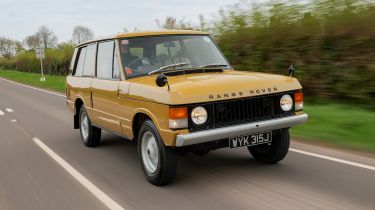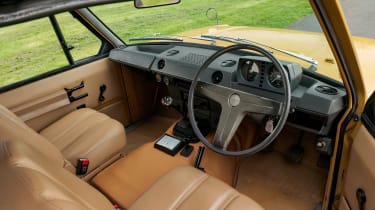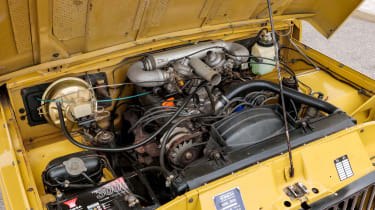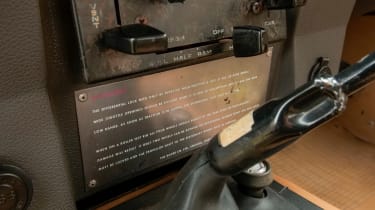Range Rover (Mk1, 1970–1994) icon drive: Britain’s first luxury SUV
We get behind the wheel of ‘a car for all reasons’
There’s no shortage of jacked-up luxury cars on the market these days, but the best of the lot might just be the Range Rover. It’d be our choice not just over all the other pretenders to the posh SUV throne, but also a chunk of the premium saloons out there, such as the Mercedes S-Class.
Perhaps that’s because its makers have had more time to perfect the recipe. The first Range Rover rolled off the production line way back in 1970, but the story can be traced back further still, to the fifties and a couple of ‘Road Rover’ models based on a Rover P4.
The point then wasn’t to make something opulent, but merely a vehicle that was more civilised and road-biased than the Land Rover series. Not exactly the highest bar for one of the most basic, utilitarian vehicles on the market, which was more at home in a field herding sheep than tackling the morning commute.
Those first projects never amounted to anything, but interest in a less agricultural off-roader within the Rover Company was revived the next decade. There were significant corporate shifts during that time, with the Rover Company being bought by Leyland, which then morphed into British Leyland following a merger. But that didn’t slow down the project all that much. By the tail end of the 1960s, 26 pre-production prototypes were built, each badged as a ‘Velar’ (derived from the Italian word ‘velare’ meaning ‘veil’) to throw competitors and the media off the scent.
Used - available now

2018 Land Rover
Range Rover
94,000 milesAutomaticDiesel3.0L
Cash £25,949
2017 Land Rover
Range Rover
60,000 milesAutomaticDiesel3.0L
Cash £26,995
2020 Land Rover
Range Rover
141,032 milesAutomaticDiesel4.4L
Cash £19,990
2023 Land Rover
Range Rover
50,934 milesAutomaticPetrol3.0L
Cash £69,400In 1970, the newly created Range Rover was ready to say hello to the world, and it had plenty to shout about, from its permanent four-wheel drive system to the innovative split tailgate – the latter being a defining Rangie feature that continues to this day. The new car ditched the Land Rover’s leaf springs for a fully coil-sprung set-up, and while it was far more road-focused, it still promised mud-plugging ability. ‘A car for all reasons,’ was how British Leyland marketed it.
At first it was offered only as a two-door vehicle, with the four-door not arriving until 1981. Three years later, the four-door would become the only bodystyle available in the UK (limited-edition CSK notwithstanding), a move that’d eventually make the two-door much more sought after. Helped, of course, by the fact that it looks far sweeter.
The Bahama Yellow model we’ve borrowed from JLR’s UK heritage fleet certainly reinforces this view. It looks positively dainty compared to its modern successor, which is more than half a metre longer and about 40cm wider.
Inside, there’s an abundance of bare metal, a plain dashboard containing only a handful of chunky, function-over-form controls and a big plaque explaining how to use the differential lock. The seats are clad in vinyl, and the floor is coated in rubber so, much like the Land Rover, you can hose it out if you get it muddy.
Clipping in the non-inertia reel seatbelt further ages the car, while winding a window up or down is – for someone with spindly arms like me, at least – a job which requires two hands. The latches on the little smoker’s windows aren’t that easy to shift, either, while low-speed manoeuvring is hard going, thanks to the unassisted steering. It’s quite a workout!
Selecting the first gear of the four-speed manual transmission requires the use of a long, wobbly gear lever whose travel through the gate seems to go on forever. Once on the move, we find out just how damn noisy this thing is compared with whisper-quiet modern luxo-SUVs. That means we get to hear a fabulous roar from the 3.5-litre engine. We all know it as the ‘Rover V8’, but it started out as a General Motors design that was modified by the British brand.
Perhaps that’s why, with a relative lack of soundproofing, the Range Rover’s soundtrack ends up being one with more than a whiff of Americana to it. At least, up to the point where the also-noisy transmission and engine fan start to compete with it.
It’s not what you’d call quick. The Rover V8 was detuned for this application, making all of 135bhp by the time it ended up under the Range Rover’s clamshell bonnet. Not that you want to be going particularly fast in this thing, given the vague responses from the huge steering wheel, which has a good helping of play around the dead-ahead. The brakes, at least, aren’t too scary by 1970s standards, so long as you put plenty of pressure on the pedal.
Another reason it’s just as well the Range Rover is rather on the sluggish side is that you don’t want to be taking corners too enthusiastically. There’s a whole lot of body roll, which – combined with a lack of bolstering and those old-school seatbelts – means it often feels like you’re going to fall out of the driver’s seat. It also doesn’t take much for the front tyres to start protesting as the Range Rover pushes on into understeer.
This thing doesn’t feel significantly less polished or refined than typical passenger cars of the era, though, and the straight-line performance is about on the money for the time. Keep the speed down a bit, and it’s a perfectly acceptable way to get around.
It’s not hard to imagine how much of a revelation the Range Rover proved when first launched – a vehicle that could be used on the road for day-to-day driving, yet still able to tackle the rough stuff if necessary. Up until that point, the only thing remotely like it was the Jeep Wagoneer, which its new British rival arguably bettered in most ways.
What we now refer to as the Range Rover Classic soldiered on all the way until 1994, improving with ever-larger versions of the V8, more plushness and tech such as ABS. The next Range Rover, the P38, had a much more typical eight-year cycle.
With each generation, the Range Rover became more and more luxurious, while remaining extremely capable off-road. From the Range Rover Classic to the current fifth-generation version, it hasn’t ever stopped being ‘a car for all reasons’.
Interested in buying one?
The Range Rover’s array of aluminium bodywork removes some of the potential for rust-based financial pain, but the many panels that are steel, the steel frame and the chassis are very susceptible to the tin worm. The front and rear cross members and the inner wings are some of the most notorious trouble spots, but corrosion can strike at many different points.
The V8s are robust, but the earlier, under-stressed 3.5-litre versions are the most reliable. Check for evidence of frequent oil changes and have a good listen for any top-end rattles. It’s also vital that the diesel engines’ cambelt
is changed on schedule.
Any examples costing under £5,000 are likely to be projects, while £10,000 should be considered the starting point for a tidy four-door. Two-doors are pricey, particularly early cars, which can go for more than £40,000.
| Model: | Range Rover Mk1 |
| Production dates: | 1970–1994 |
| Price then: | From £1,500 |
| Price now: | From £10,000 |
| Engine: | 3.5-litre V8 petrol,135bhp |
| 0–62mph: | 14 seconds |
| Top speed: | 91mph |







